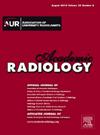利用基于肩部磁共振成像的多模态放射组学加强肩胛下肌肉损伤的术前诊断
IF 3.8
2区 医学
Q1 RADIOLOGY, NUCLEAR MEDICINE & MEDICAL IMAGING
引用次数: 0
摘要
理由和目标:肩袖损伤是肌肉骨骼系统中常见的一种疾病,肩胛下肌是肩袖中最大、最强壮的肌肉。肩胛下肌撕裂的发生率高于以往的报道。这项研究的主要目的是利用人工智能的力量,在手术干预前通过肩关节磁共振成像提高肩胛下肌损伤诊断的精确度。本研究试图整合先进的人工智能算法来分析磁共振成像数据,旨在提供更准确的术前评估,从而有可能带来更好的手术效果和患者护理,并促进医学影像分析领域的技术进步:这是一项多中心研究,由一家大型医疗中心的 324 名患者组成培训组和测试组,另外 60 名来自另外两家医疗中心的患者组成验证组。所有受试者的成像方案包括一系列肩部磁共振成像扫描:T1 加权冠状位序列、T2 加权冠状位、轴位和矢状位图像。利用这些全面的成像模式来彻底检查肩关节的解剖细节,并检测肩胛下肌损伤的任何迹象。为了提高手术前诊断的准确性,我们采用了放射线组学分析。这项技术包括从磁共振成像中提取大量定量特征,从而提供一种更加细致入微、以数据为导向的方法来识别肩胛下肌损伤。在这项研究中整合放射组学,旨在提供更精确的术前评估,从而改善手术规划和患者预后:结果:在这项研究过程中,针对每位患者的每种成像模式,全面提取了 1197 个放射线组学特征。在内部验证队列中评估冠状 T1 加权模式时,诊断准确率为 0.766,AUC 为 0.803。在 T2 加权模式中,冠状面的诊断准确率为 0.781,AUC 为 0.844。轴向 T2 加权图像的准确率为 0.719,AUC 为 0.761,而矢状 T2 加权图像的准确率为 0.766,AUC 为 0.821。通过多模态策略将这些成像技术相结合,内部验证组的准确率明显提高到 0.828,AUC 为 0.916。在外部验证组中,冠状 T1 加权模式的诊断准确率为 0.833,曲线下面积(AUC)为 0.819。对于 T2 加权模式,冠状成像的准确度为 0.767,AUC 为 0.794。轴向 T2 加权图像的准确度为 0.783,AUC 为 0.797,而矢状 T2 加权图像的准确度为 0.833,AUC 为 0.800。当结合各种模式时,多模式方法显著提高了准确率,达到 0.867,外部验证组的 AUC 为 0.803,显示出强大的诊断能力:我们的研究表明,将多模态放射成像技术应用于肩部磁共振成像可显著提高肩胛下肌损伤术前诊断的准确性。这种方法充分利用了各种磁共振成像模式提供的全面数据,可提供更详细、更准确的评估,这对手术规划和患者护理至关重要。本文章由计算机程序翻译,如有差异,请以英文原文为准。
Enhancing Preoperative Diagnosis of Subscapular Muscle Injuries with Shoulder MRI-based Multimodal Radiomics
Rationale and Objectives
Rotator cuff injury is a common ailment in the musculoskeletal system, with the subscapularis muscle being the largest and most robust muscle of the rotator cuff. The occurrence of subscapularis muscle tears is more frequent than previously reported. The main objective of this research is to harness the power of artificial intelligence to enhance the precision in diagnosing subscapularis muscle injuries via magnetic resonance imaging of the shoulder joint, prior to surgical intervention. This study seeks to integrate advanced artificial intelligence algorithms to analyze magnetic resonance imaging data, aiming to provide more accurate preoperative assessments, which can potentially lead to better surgical outcomes and patient care and promote technological progress in the field of medical imaging analysis.
Method
This is a multicenter study that involves 324 patients from a major medical center serving as both the training and testing groups, with an additional 60 patients from two other medical centers comprising the verifying group. The imaging protocol for all these subjects included a series of shoulder magnetic resonance imaging scans: T1-weighted coronal sequences, T2-weighted coronal, axial, and sagittal images. These comprehensive imaging modalities were utilized to thoroughly examine the shoulder joint's anatomical details and to detect any signs of subscapularis muscle damage. To enhance the diagnostic accuracy before surgical procedures, radiomic analysis was employed. This technique involves the extraction of a multitude of quantitative features from the magnetic resonance imaging, which can provide a more nuanced and data-driven approach to identifying subscapularis muscle injuries. The integration of radiomics in this study aims to offer a more precise preoperative assessment, potentially leading to improved surgical planning and patient outcomes.
Result
In the course of this study, a comprehensive extraction of 1197 radiomic features was performed for each imaging modality of every patient. The coronal T1-weighted modality, when assessed within the internal verifying cohort, delivered a diagnostic accuracy of 0.766, coupled with an AUC of 0.803. In the case of the T2-weighted modality, the coronal planes exhibited a diagnostic accuracy of 0.781 and an AUC of 0.844. The axial T2-weighted images recorded an accuracy of 0.719 and an AUC of 0.761, while the sagittal T2-weighted images scored an accuracy of 0.766 and an AUC of 0.821. The amalgamation of these imaging techniques through a multimodal strategy markedly enhanced the accuracy to 0.828, with an AUC of 0.916 for the internal verifying group. The diagnostic performance of the coronal T1-weighted modality in the external verifying cohort yielded an accuracy of 0.833, with an area under the curve (AUC) of 0.819. For the T2-weighted modality, the coronal imaging demonstrated an accuracy of 0.767 and an AUC of 0.794. The axial T2-weighted images had an accuracy of 0.783 and an AUC of 0.797, while the sagittal T2-weighted images achieved an accuracy of 0.833 and an AUC of 0.800. When combining the modalities, the multimodal approach significantly improved the accuracy to 0.867, with an AUC of 0.803 in the external verifying group, indicating a robust diagnostic capability.
Conclusion
Our study demonstrates that the application of multimodal radiomic techniques to shoulder magnetic resonance imaging significantly enhances the precision of preoperative diagnosis for subscapularis muscle injuries. This approach leverages the comprehensive data provided by various magnetic resonance imaging modalities to offer a more detailed and accurate assessment, which is crucial for surgical planning and patient care.
求助全文
通过发布文献求助,成功后即可免费获取论文全文。
去求助
来源期刊

Academic Radiology
医学-核医学
CiteScore
7.60
自引率
10.40%
发文量
432
审稿时长
18 days
期刊介绍:
Academic Radiology publishes original reports of clinical and laboratory investigations in diagnostic imaging, the diagnostic use of radioactive isotopes, computed tomography, positron emission tomography, magnetic resonance imaging, ultrasound, digital subtraction angiography, image-guided interventions and related techniques. It also includes brief technical reports describing original observations, techniques, and instrumental developments; state-of-the-art reports on clinical issues, new technology and other topics of current medical importance; meta-analyses; scientific studies and opinions on radiologic education; and letters to the Editor.
 求助内容:
求助内容: 应助结果提醒方式:
应助结果提醒方式:


